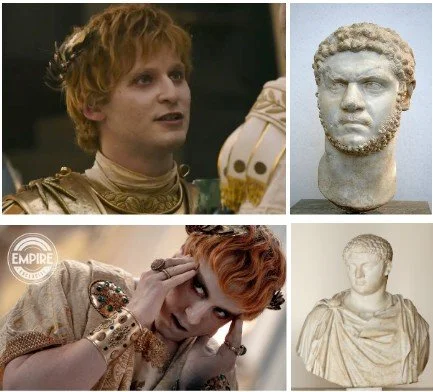This Roman historian was not entertained by Gladiator II
From the minute we heard about this movie, I said to my friends there was no WAY I would write a think piece about Gladiator II, let alone watch it, and yet, here we are: I've both watched and think-pieced. Chief among the thoughts being pieced are the treatment of Caracalla and Geta, Macrinus, and women rooted in modern culture war discourse.
The concept of a sequel was, admittedly, baffling to me with the way Gladiator ended, leaving no room for interpretation. Or so I thought. There were plans for a sequel that initially included a zombified Maximus timehopping between medieval and modern warfare, but that was too bonkers for even Russell Crowe to get behind. When Gladiator II was announced, I wasn’t moved by the hype. Instead, I eagerly anticipated the thoughts and opinions I’d no doubt start hearing from academics and enthusiasts alike. Despite my initial lack of interest, I decided to watch it anyway because it was (American) Thanksgiving, and rather than be cooped up alone in my apartment, I thought, “why not?”. Well, I watched it, and knowing my friends were awaiting my hottest take, I tweeted the following before I left the theatre parking lot:
Full disclosure that I am going to be a total killjoy for the entirety of this essay, so let me say right now that Denzel Washington must be exhausted after carrying that entire film. Gladiator II was 2 hours and 28 minutes of pure aggravation, with Denzel as its saving grace, delivering an outstanding and entertaining performance. But, Denzel aside, there were many things about Gladiator II that I found to be anywhere on a spectrum between straight up lazy and downright infuriating. Instances of laziness include following the same plotline of Gladiator, using the same music and scenes from the first movie, incorrectly referring to two gold coins as denarii (silver coinage), and blatantly ripping off Caligula (spoiler: a pet monkey gets appointed consul – how groundbreaking).
What I found to be particularly egregious was the treatment of the young Severan emperors. As someone who studied under a Severan scholar and has written extensively on the dynasty (193 - 235 CE), I had several issues. For a historical consultant to suggest that Ridley Scott is an “artist, not a historian” is an absurd, cop-out response to what is inherently a bad movie, from careless writing to cheap stereotypes rooted in modern culture war discourse.
Gladiator II downplays the actual historical significance of Caracalla and Geta by eliminating any traces of their mixed African and Syrian heritage, from their parents, Septimius Severus from Leptis Magna in modern Libya and Julia Domna from Emesa in Syria. Additionally problematic were the elements of queer coding for the antagonists and racial undertones in the characterization of Macrinus as the “angry black man,” despite being a freedman. I’d also be remiss to not mention the piss-poor treatment of women in this film. The fact of the matter is, the only two female characters in this entire movie are killed off with an arrow straight to the chest. Either Ridley Scott doesn’t know how or forgot to write women’s roles (which is likely true), or these female characters are meant to serve as a warning to not interfere in traditionally masculine spaces, i.e. politics and warfare.
These are deliberate choices made by Ridley Scott. But why? In recent years, American politics and media has fixated on DEI (an acronym for diversity, equity, and inclusion) initiatives, all of which have been under attack by conservatives and right-wing media as being “woke”. Critics claim that DEI initiatives discriminate against white (mostly male) Americans by privileging other disadvantaged groups and that such policies push a certain (leftist) ideology. These grievances against DEI have been aired every day on most major media conglomerates and are part of the culture war narrative. I contend that Gladiator II is not a neutral film featuring cool fights and flashy CGI battles in the Colosseum, but a direct product of that culture war. My purpose here is to provide historical context to the Severan emperors and emphasize that, despite this film not being remotely “woke”, it is still criticized as such by ultraconservatives whom Hollywood will never and can never hope to win over.
I do get that expecting historical accuracy in a big-budget Hollywood production is naïve, and Ridley Scott’s response to the criticisms of French historians regarding Napoleon certainly confirms that notion. I also concede that although Gladiator II did “my boys” dirty, the original film is genuinely entertaining. What I like about Gladiator was that, despite being fictional, the characters and events were thematically tied into the period it covers and were done with some accuracy compared to the sequel. It also helps that the movie itself is captivating and quotable, and Russell Crowe is a wonderful Maximus. Likewise, Joaquin Phoenix’s performance as Commodus was enjoyable and he embodied the personality of the emperor despite looking nothing like the man himself. The same cannot be said regarding the portrayal of Caracalla and Geta in Gladiator II.
We’re introduced to a pair of emperors – twins who are codependent on each other. The relationship between Caracalla and Geta in Gladiator II is purely fictional, as the real, historical brothers hated each other until one of them eventually ended up dead and formally condemned via damnatio memoriae (condemnation of memory). It’s also worth mentioning that their real life counterparts were not twins, as Caracalla was famously the older, more dominant sibling. This decision to make Caracalla and Geta twins was Scott’s version of Romulus and Remus, but as “damaged goods from birth”.
In Gladiator II, the twins are despotic emperors bent on territorial conquest to fund their lavish lifestyles. They are more concerned with fuelling their decadence than attending to civic matters. The film’s version of Caracalla is smaller, weaker, and, in an attempt to queer code him as our supreme villain, dresses ostentatiously – a purposeful, hard shift from the historical Caracalla who was far more interested in military affairs and projecting a soldierly image. In fact, Caracalla, whose real name is Lucius Septimius Bassianus (later changed to Marcus Aurelius Antoninus, named after his adoptive grandfather Marcus Aurelius) is merely a nickname for the fact that he often wore a Gallic hooded tunic known as the caracallus. Caracalla was violent and reckless, yes, but not insane as Gladiator II implies. His insanity is explained as a symptom of him having syphilis, despite there being no evidence to suggest he had the malady. Geta’s murder is far more shocking and brutal than it was depicted in Gladiator II, and Caracalla executed it fully sane.
According to Cassius Dio, Caracalla convinced their mother, the empress Julia Domna, to host a meeting to negotiate a peace between himself and Geta. When they convened at their mother’s apartment, Caracalla gave the signal to some centurions to attack Geta upon entering, who then rushed into his mothers’ arms. Dio describes the scene,
“And so she, having fallen for this deception, beheld her son dying a most abominable death in her very lap, a death she received into the very same womb, as it were, from which he was born, since she was drenched all over with blood, and took no account of the wound inflicted on her hand.” (Cass. Dio. 78.2.4)
The Historia Augusta and Herodian offer different accounts of Geta’s murder, but the result is the same and ends with Geta’s violent death as schemed by Caracalla. Following the death of Septimius Severus, the Historia Augusta reports that Caracalla complained to the soldiers that Geta was conspiring against him. Herodian states that the tensions got so extreme the brothers tried convincing each other’s cooks and cupbearers to deliver the poison until Caracalla finally gave into his desires and murdered his brother, becoming sole emperor. In Gladiator II, Caracalla kills Geta by slashing his hand and, with Macrinus’s assistance, guides Caracalla into slashing Geta’s throat eventually decapitating him.
At the risk of sounding morbid, either of these accounts is far more compelling and dramatic than the version presented in the movie. More importantly, it demonstrates how deliberate Caracalla was in using violence to eliminate political enemies and possible threats. Gaius Fulvius Plautianus, who served as Septimius Severus’ praetorian prefect and was Caracalla’s father-in-law, was executed on a charge of treason, and his corpse was left exposed, all because he was gaining too much power, which threatened the succession of the emperor’s sons. Following on the purported advice Septimius Severus gave his sons on his deathbed, “be harmonious with each other, enrich the soldiers, and scorn all the rest”, once Caracalla became sole emperor, he would spend vast sums of money on his soldiers. His excessive spending, however, prompted the empress to scold him. Caracalla responded by telling her to be optimistic, “for as long as we have this,” flashing his sword, “we will have no shortage of cash”. How comforting. The historical Caracalla was legitimately a more frightening and capable villain than the one in Gladiator II that was consciously inspired by Beavis and Butthead.
Aside from flamboyant mannerisms and costuming, the portrayal of Caracalla and Geta as pale redheads is surprising for those familiar with this dynasty. On the one hand, the combination of Caracalla’s anemic and syphilitic appearance, as well as Geta’s heavy eyeshadow, are deliberate attempts at queer coding by Scott and co. On the other hand, the intentional whitewashing of the Severan brothers’ ethnicity is a deliberate shift from what we know about their heritage. Septimius Severus was the first emperor from North Africa and Julia Domna was the daughter of a high priest from Syria – so the brothers would not have been the whitest kids. We also have portraits of Caracalla, and the very few that remain of Geta, to confirm their mixed heritage. To my mind, the only reasons why a director would swap out ethnicities is to either diminish the impacts of the historical Caracalla and Geta as men of Afro-Asiatic heritage or, perhaps more pessimistically, to avoid any backlash or accusations of “DEI” and “woke” by the right-wing mob and media.
Rightwing spaces erupted when Paramount released the trailer, which became the target of intense review-bombing and overwhelmingly negative comments on YouTube. Points of criticism ranged from giving too much of the film away (a valid point), the incorporation of rap music feeling inappropriate for a movie about Rome (the song in question is “No Church in the Wild” by Kanye West and Jay-Z), and the inclusion of Denzel Washington as Macrinus. These last two particular criticisms quickly became dog whistles.
While some complained that Washington’s accent was too American for the role (a moot point when the Romans did not have British accents either), others were explicitly racist. Most of these remarks can be reduced to “forcing diversity where it doesn’t belong ruins movies.” Even the richest man on the planet felt so compelled to share his very thoughtful input on the movie.
The thing these bigoted assholes fail to understand, or even acknowledge, is that there were citizens that would now be referred to as people of color in the Roman Empire and they routinely occupied positions of power. The historical Macrinus was a North African who served as Caracalla’s praetorian prefect, who later helped overthrow him and ruled for just over a year before being overthrown in turn by Elagabalus. In Gladiator II, Macrinus is a former prisoner of war who served as a slave under the emperor Marcus Aurelius. Macrinus earned his freedom from gladiatorial victories in the arena and eventually became an arms dealer. His goal throughout the film is gaining the seat of imperial power and, ultimately, seeking revenge on his former master. The implication of Macrinus, a former slave, wanting revenge against his former white master, may be interpreted as not being grateful enough to his oppressors and must be violently suppressed, a stereotype that has existed since the early days of American slavery. Though this portrayal might not be intentional, it’s a lazy trope to lean back on unchecked.
Macrinus, like Geta and Caracalla, is unkindly framed as queer for the purpose of building his villain credentials. Interestingly, Washington said he filmed a gay kiss scene (“a kiss of death”) but it was cut from the movie. Scott denies this ever happening, which begs the question of why Washington would make it up if that were the case. As Denzel says, it was not a “sexy kiss” but the kiss itself can be interpreted as the ultimate power move for a former slave to be on the same level as the ruling elite. Leaving this kiss scene would have shocked conservative audiences all the more. Here is the thing, though… the Roman Empire was diverse, both ethnically and in sexual practices, and no amount of complaining about “DEI” and “woke” is going to change those facts. These are the sort of people who identify with Maximus but are actually more like Caracalla and Commodus, who demand to be the center of attention and adored without merit. Despite some folks’ dissatisfaction, Paul Mescal (who plays Lucius, son of Maximus) believes Gladiator II will appeal to a range of audiences including “the guys, the gays, the girls, the mums, the dads,” as well as “the bros”.
Even Roman women possessed considerable influence and played a critical role in legitimating emperors. Some handled the more bureaucratic side of the empire (Julia Domna during Caracalla’s solo reign) and in some cases went so far as to act as regent (Agrippina the Younger presiding over Nero as well as many Byzantine empresses). That is not to say Rome was an egalitarian paradise where everyone could participate and hold power, but it is not as black-and-white as Gladiator II suggests.
Lucilla (played by Connie Nielsen) becomes a political pawn, used by the emperors to demonstrate that the games are in honor of her father, Marcus Aurelius. Her soft power is put to an end with an arrow straight to the chest in the arena for everyone to witness. Lucilla’s public death is reminiscent of the martyrdom of Perpetua, who was executed for her Christian faith. The spectacle of Lucilla’s death serves as a warning, mostly to women, to know their place within this patriarchal society, otherwise they risk getting shot with an arrow. Actual Romans would be horrified by the grotesque display of a woman getting shot in the chest. Public executions were reserved for the lower orders. For a member of the imperial family or senatorial elite to be subjected to death in the arena would have been scandalous and ignominious. The reaction would have been similar to those of the senatorial elite whenever Commodus would perform in the arena.
Additionally problematic is the near-exclusion of Egyptian-Palestinian actress May Calamawy in Gladiator II. Calamawy was cast as Acacius’ love interest (played by Pedro Pascal) and played a critical role in the film. When the trailer was released and they started promoting the film, fans noticed Calamawy’s absence despite being listed on the cast. Fans suggest that Calamawy was cut from the film due to her support of Palestine, though it remains unclear if this was actually the case or general confusion regarding her role in the film. Still, despite reports around her critical role in the film, her diminished presence is a major disappointment when it comes to the representation of women in Gladiator II. Almost all of Calamawy’s scenes were cut from the film and she was reduced to a non-speaking role. If she was cut from the film due to her pro-Palestinian stance, it demonstrates why celebrities are fearful about expressing pro-Palestinian sentiments.
Ultimately, Gladiator II is an ideologically motivated film that reflects the views of a reactionary individual, who cannot be bothered hiring more than one non-white cast member. The characterization of Caracalla and Geta as ineffectual and effeminate tyrants was, I believe, a conscious choice made by the director. Scott’s portrayal of the two Severan emperors is rooted in old, tired Hollywood tropes and culture war discourse. Additionally, the queer coding and portrayal of Macrinus only perpetuates racist stereotypes of the “angry black man” not being grateful enough to his oppressors who must be suppressed. The treatment of women in the film sends a message that women should not be in or near positions of power, and, ultimately, that they do not belong in a patriarchal society.
If you are interested in reading more about actual gladiators, Alexandra Sills masterfully provides context for what gladiators actually did and dispels some of the whackier things we see in the movie (including those damned sharks in the arena). Additionally, Alexandra’s articles on Gladiator II including her first impressions and critical analysis of the film are also well worth reading. Bret Devereaux’s Gladiator II review, moreover, offers an excellent overview of the Severan period more broadly, including its military aspects. All translations in this piece were kindly provided by Jeremy Swist.
About the author
Christina Hotalen earned her PhD specializing in the late Roman Empire. Her research interests are gender, material culture, digital humanities, and classical reception in heavy metal. She also makes chainmaille in her spare time.




